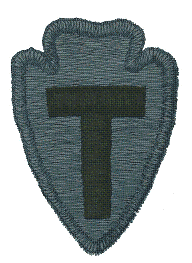36th Infantry Division



"Fighting 36th"
"Lone Star Division"
"Panther Division"
The 36th Division insignia consisting of an olive drab "T" on a blue flint arrowhead was adopted in 1918. In World War I, the division was organized from National Guard units of Oklahoma and Texas; the flint arrowhead represents the State of Oklahoma (once the Indian Territory), and the "T" is for Texas.
The 36th Infantry Division was originally activated as a National Guard Division from Texas and Oklahoma in July 1917. The unit was sent to Europe in July 1918 and conducted major operations in Meuse-Argonne. During World War I the division suffered 2,584 casualties consisting of 466 killed in action and 2,118 wounded in action. The unit was inactivated in June 1919.
The unit was again activated prior to World War II on November 25, 1940. The unit deployed overseas on April 2, 1943.
The 36th Infantry Division landed in North Africa, 13 April 1943, and trained at Arzew and Rabat. It first saw action, 9 September 1943, when it landed at Paestum on the Gulf of Salerno. The waiting enemy launched counterattacks, but the 36th advanced slowly, securing the area from Agropoli to Altavilla. After a brief rest the 36th returned to combat, 15 November. It captured Mount Maggiore, Mount Lungo, and the village of San Pietro despite strong enemy positions and severe winter weather. This grueling campaign was marked by futile attempts to establish a secure bridgehead across the Rapido River, 1 January to 8 February 1944.
After assisting the 34th Division in the attack on Cassino and fighting defensively along the Rapido River, the 36th withdrew, 12 March 1944, for rest and rehabilitation. On 25 May, the Division landed at Anzio, drove north to capture Velletri, 1 June, and entered Rome on the 5th. Pushing up from Rome, the 36th encountered sharp resistance at Magliano, but reached Piombino, 26 June, before moving back to Paestum for rest and rehabilitation. On 15 August, the Division made another assault landing against light opposition in the RaphaelFrejus area of Southern France.
A lightning dash opened the Rhone River Valley. Montelimar fell, 28 August, and large Nazi units were trapped. The 36th advanced to the Moselle River at Remiremont and the foothills of the Vosges. In a grinding offensive, the Division crossed the Meurthe River, breached the Ste. Marie Pass and burst into the Alsatian Plains. The enemy counterattacked, 13 December, and the 36th held in the Colmar Pocket. On the 20th the Division resumed the attack, advancing northward along the Rhine River to Mannheim meeting heavy resistance at Haguenau, Oberhofen, and Wissembourg. The 36th moved to the Danube, 22 April 1945, and attacked the "National Redoubt" at Kunzelsau on the 30th in its final action.
The unit had 400 days of combat. The unit returned to the United States in December 1945 and was inactivated at the same time.
On May 1, 2004, the 49th Armored Division was officially inactivated and the 36th Brigade of the 49th Armored Division was redesignated the 36th Infantry Division. The ceremony officially marking the activation of the division will take place on October 2, 2004. After half a century, the 36th ID (formally the 49th Armored Division) was reactivated to help transform the Texas Army National Guard into a more mobile and lethal fighting force that will see a new generation of T-Patchers committed to helping fight the global war on terrorism and carry on the proud legacy established by their predecessors.
The organization of the 36th Infantry Division is still unclear, as the Army is undergoing a transformation to brigade units of action and the 36th is not expected to complete its reorganization until 2006.


